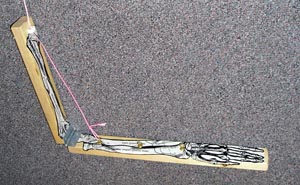
A model for the lever in the human forearm. Click to
enlarge.

A model for the lever in the human forearm. Click to
enlarge.
Introduction
The human arm is an interesting example of a lever. The force exerted by the biceps muscle is on the same side of the elbow pivot as the distant hand which is moved by the muscle. A large force exerted over a short distance by the muscle creates a lesser force exerted over a greater distance by the hand.
Material
Two pieces of 1 x 2 wood board ( 2 x 5 cm), one board about 40 cm (16 inches) long the other about 22 cm (9 inches) long.
a hinge and screws
4 cup hooks
a coaxial nail-in clip (You can also use a screw eye or a cup hook)
Drill, bits, and screwdriver.
a string 50 cm (20 inches) long
a one liter water bottle. and a small loop of string to attach the water bottle to the cup hook at the end of the arm.
Assembly
Attach the two boards with the hinge.
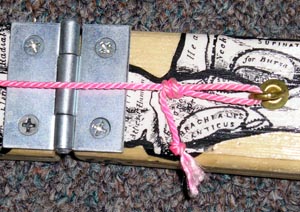
Screw in the cup hooks in the longer board 5 cm, 15 cm, and 20 cm from the center of the hinge.
Screw one cup hook into the bottom of the long board 30 cm from the hinge.
Install the coaxial nail-in clip near the top of the shorter board.
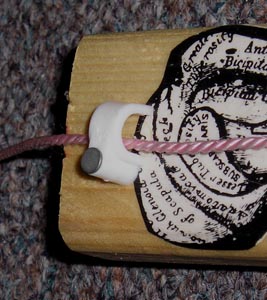
Tie a loop into one end of the string
Thread the string through the coaxial nail-in clip. with the loop end pointing down, Connect the loop to the nearest cup hook. (See photo above.)
To Do and Notice
Pull on the string until the boards make a right angle.
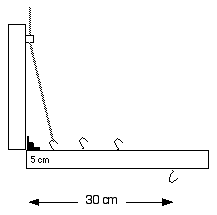
Now pull on the string to raise the arm.
Notice how far you have to pull the string to raise the arm to a 45 degree angle. Notice how much force it takes to lift the arm.
Disconnect the string from the nearest cup hook and attach it to the cup hook 20 cm from the hinge.
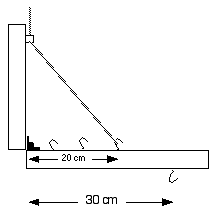
Starting with the arm at 90 degrees pull on the string to lift the arm.
Notice how far you have to pull the string to raise the arm to a 45 degree angle.
Notice how much force it takes to lift the arm.
Now tie the one liter water bottle to the cup hook at the bottom of the arm this adds about a kilogram of weight to the arm.
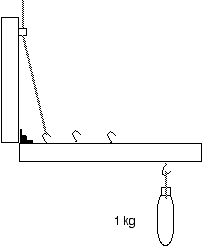
Repeat the above experiments.
Notice that when the string is attached to the 5 cm cup hook it takes a large force to raise the water bottle but the string only has to be pulled a short distance.
Notice that when the string is attached to the 20 cm cup hook it takes a smaller force acting over a longer distance to raise the bottle.
What's Going On?
The arm is a lever.
Unlike the classic levers that appear in science textbooks in which a person exerts a force over a large distance which the ever converts into a larger force over a smaller distance, the lever in the arm converts a force in a muscles acting over a short distance into a lesser force exerted over a longer distance.
In a human arm the biceps muscle is connected in a position close to the elbow, just as the cup hook at 5 cm from the hinge is in our model.
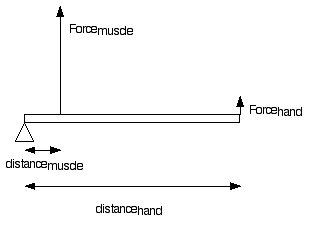
Math Root
In a lever energy is conserved.
The work done by the muscle, Wm, must equal the work done by the hand, Wh.
Since work is force, F, times distance, d, then we have:
Wm = Wh
Fm *dm = Fh * dh
or equivalently since we know dh/dm = 30/5 = 6
then Fm = Fh * dh/dm
Fm = 6 Fh
In order for the hand to exert 100 newtons of force the muscle must exert 600 newtons of force.
To lift a 100 pound weight the biceps must exert 6 * 100 = 600 pounds of force.
Going Further
You will need a spring scale which can read 20 newtons.
You can use a spring scale to measure the force needed to lift a partially full one liter water bottle. The mass of a one liter bottle is 1 kg, the weight of the bottle is 10 N. fill the bottle with 250 mL of water and it will weigh 2.5 newtons. Ignoring the mass of the arm, friction, and the angle the string makes when it connects to the cuphook, the force needed should be six times this or 15 N Newtons. What is it?
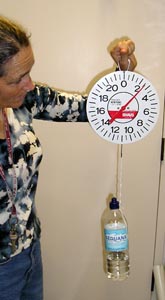
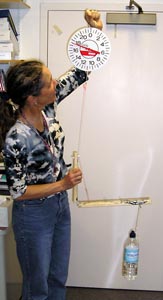
Lori uses a scale to measure the force exerted by the tendon to lift
the water bottle.
How can you figure out the contribution of friction to your answer? Click for answer
The contribution of the angle of the string? Click for answer
and
The contribution of the weight of the arm itself? See the next image for the answer.
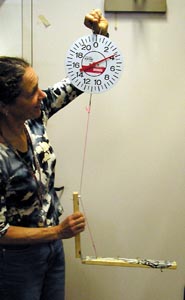
So What?
If you hold your arm as if you are going to shake hands, keeping your elbow at 90 degrees, and hold onto a 20 pound weight with your hand then your muscle must be pulling your forearm upward with over 120 pounds of force.
In addition the bone of the upper arm must be pushing down on the lower arm bones with a force of almost 100 pounds. The body must be designed to withstand these large forces.
Etc.
Imagine you are an engineer you are assigned to design a lever system, it must be able to lift 250 newtons (50 pounds) over a distance of 1 meter, and to place it within a millimeter of a desired position. It has to do this for 80 years with no maintenance. When you can do this you are ready to design an arm.
Answers
1.)To find the effect of friction pull on the string with the scale until the arm just begins to rise, measure the force, then allow the arm just begins to fall and measure the force. Friction always opposes motion so the friction force will add to the force necessary to raise the arm and subtract from the force needed to lower the arm. The difference in these two measurements will give you an idea of double the friction force. For example, if it takes 19 newtons to raise the arm and 17 newtons to lower it the friction force is half the difference or 1 newton.. Return
2.) Disconnect the string from the cable tie so that the string goes straight up. Measure the force and compare it with the force needed when the string goes through the cable tie. Don't forget to correct for friction. Return
|
Scientific Explorations with Paul Doherty |
|
15 April 2005 |